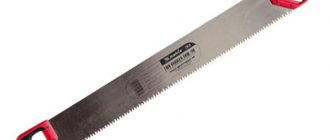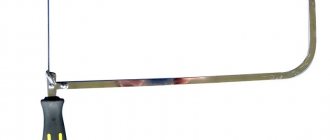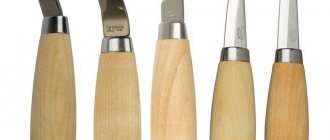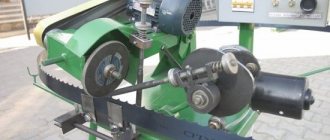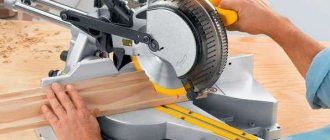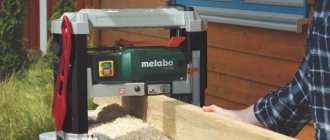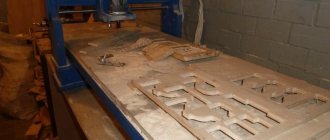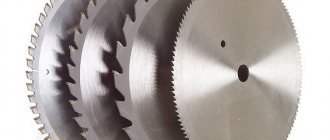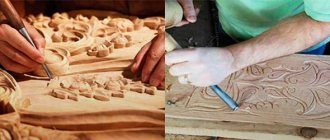A kerf is a gap formed in wood when narrow shavings and sawdust are cut by the teeth of a cutting tool. At the cut, we can identify several parameters with which the teeth of the cutting tool interact, such as the side walls and bottom. Also, the width of the cut, which determines the amount of wood material sent to waste, which in turn is determined by the size of the cutting part of the tool.
Due to the characteristics of the structure of the wood material, sawing directed along the grain, sawing across the grain and mixed sawing are distinguished.
Sawing in the direction along the grain of the wood is called “longitudinal”. When longitudinally sawing wood, the main cutting edge of the cutter, which is one saw tooth, performs end or longitudinal end cutting. The side edges of the saw tooth produce transverse or longitudinal-transverse cutting. An example of longitudinal sawing is cutting a carriage into boards on a multi-rip machine, sawing a log into unedged boards on a band saw, or trimming the edge of an unedged board on a specialized edging machine.
Sawing in a direction across the grain of the wood is called cross-cutting. When cross-cutting wood, the main cutting edge of the saw tooth cuts across the grain, and the side edges at the end. An example of cross-cutting is the operation of “trimming” workpieces, carried out on cross-cutting machines.
In the case of mixed cutting or cutting at an angle to the direction of the wood fibers, the main cutting edge of the saw tooth produces a face-transverse or face-transverse-longitudinal cutting. The side edges of the saw tooth produce transverse end cutting.
Sawing when cutting different wood materials such as plywood, particleboard or fibreboard will always be mixed. This is due to the multidirectional orientation of the fibers that make up the board along the thickness of the treatment.
Tools and equipment for wood processing
Sawing can be used to cut boards into pieces, saw boards into bars and slats, trim parts and boards, saw boards and plywood, trim edges, cut out curved and shaped parts.
When longitudinal cutting, first cut off the uneven edge or defective part of the board (this can be done “by eye”), then the board is sawn.
When cutting crosswise, first cut off the end of the board (end), since it usually has defects (unevenness). Then, depending on the defects, a part of the board of the required length is cut off. When cutting on machines, limiters (stops), guide rulers and other devices are used. Carpentry hand saws are used for sawing. According to the principle of their design, they are divided into two types - bow saws and hacksaws.
Bow saws include:
— transverse — for cross-cutting;
— loose (swinging) — for longitudinal sawing of long boards;
— tenon — for clean filing of ends, sawing of tenons and eyes;
— fine-toothed — for clean cross-cutting with increased precision;
— rotary (circular) — for figured cutting;
- jigsaw - for cutting out openwork and curved parts.
With a bow saw you can cut wood along and across the grain, as well as at an angle to it. For longitudinal sawing, it is better to use a saw with a long blade and large teeth. For mixed sawing (thin clean cuts, tenons, etc.), it is better to use a saw with fine teeth. For cutting curved shapes, a saw with a narrow blade (7-8 mm) and fine teeth is better suited.
Knife saws - hacksaws - include:
— wide hacksaws — for transverse, straight cutting of boards;
— narrow hacksaws — for figured cutting along the internal contour of the workpiece;
- axle saws - for adjusting joints, shallow sawing, sawing small parts, etc.;
- awards - for cutting grooves, recesses to a shallow depth, etc.
To prevent the saw blade from jamming, set the teeth , i.e., their tops are bent to the side by 2/3 of the tooth height (non-even teeth in one, even teeth in the other). The bend size is approximately equal: for sawing dry, hard wood - 0.25-0.5 mm, soft, wet - 0.5-1.0 mm. The largest spread should not exceed twice the thickness of the saw blade. The amount of spread for all teeth should be the same; in this case, all teeth will participate evenly in the work and bear the same load.
In order for the saw to work well, all teeth must be the same height. To do this, they are planed and then sharpened.
Electric cutting tool
Modern manufacturers offer an electrified version of devices for cutting surfaces made of various materials to perform large volumes of work with minimal physical effort.
Reciprocating type electric saw. The ability to use blades of various lengths or widths as cutting devices, as well as various tooth sizes, determines the versatility of using this tool. This makes it possible to successfully work not only with wooden products, but also to effectively cut metal and plastic.
The main parameter of a reciprocating saw (piranha) is its power, which ranges from 400 to 1600 W. The depth of cut completely depends on the power of the unit. For household hacksaws it is up to 90 mm, but a professional tool is capable of cutting parts up to 200 mm.
Disk devices
The advent of the electric motor forced the inventors of the tool to think about the idea of replacing the reciprocating motion of the blade with circular rotation of the cutting device. It is this principle of operation that is used in circular saws, the advantage of which is high power and mobility compared to hand hacksaws.
Structurally, circular-type electric saws are divided into units without a gearbox and geared models. In the first option, the disk is mounted directly on the rotor shaft of the electric motor, which makes it possible to reduce the weight of the entire unit and make it more affordable in terms of price.
In gear units, rotation to the saw blade from an electric motor is transmitted through a gear system, on the shaft of which the disk itself is attached. A feature of the working discs is the angle of inclination of the cutting teeth. In passive elements, the teeth are inclined against the direction of rotation (the sharpening angle is negative), while in active blades they are bent in the direction of rotation.
Active discs are used for processing wood, while passive discs are most often used for sawing metal products. The performance characteristics of circular saws directly depend on the power of the electric motor used (0.65-2.5 kW).
Chain devices
When harvesting firewood and felling wood, the main indicator is the depth of the cut, and not the accuracy and cleanliness of the cut. It is for this task that a chain saw with a powerful gasoline or electric motor is used.
The cutting depth depends on the length of the chain saw bar. A tire is two plates connected to each other, at one end of which there is a driven sprocket, and at the other a tensioning mechanism is installed. Chain saws with an electric motor have a power of 1.5 to 4 kW. For household use, it is enough to choose a tool with a power of up to 2 kW and a bar length of 30-40 cm.
Electric jigsaw
An electric jigsaw uses a narrow cutting blade that moves up and down at a high frequency. Thanks to this movement, the device is able to accurately and correctly cut various curved parts from plastic, plywood and ceramics.
Manufacturers of this jigsaw offer a whole set of special blades that differ in the frequency and inclination of the cutting teeth. Quick installation and change of blades is the main operational advantage of this type of cutting tool.
Technical characteristics of household models are:
- cutting depth of steel sheet is from 4 to 20 mm, and wood - 45-80 mm;
- engine power from 400 to 900 W;
- movement frequency up to 3 thousand revolutions per minute.
Some models use a very useful option - a laser pointer, which helps you clearly see the marking line.
Belt type tool
The working part of such a device is a closed steel strip with teeth, which is driven by an electric motor.
The cutting process on a band saw is much easier than working with a jigsaw, which tends to escape from your hands and vibrates very strongly. The ability to hold the workpiece with both hands greatly improves the accuracy and quality of cutting any curved elements.
The main performance indicator of band-type equipment is considered to be a fairly large cutting depth, which ranges from 8 to 50 cm. The remaining characteristics depend entirely on the cutting blades used.
The design of a metal table saw has little difference compared to a wood cutting jig. However, it can only make a cross cut of a steel angle, pipe or fittings at the desired angle.
Wood sawing tools
The following saws are used for sawing: bow saws (wooden and yoke), hacksaws, award saws, universal saws, circular saws and jigsaws.
Wood bow saws
(Fig. 1.6,
a)
consist of a wooden machine (beam) and a blade with teeth. The wooden machine is equipped with two stands, a spacer, a screw and handles. The saw blade is tensioned using a bowstring made of string or wire.
Bow yoke saws
(Fig. 1.6,
b)
are recommended for cross-cutting thick boards and beams. The saw is a frame (arc) made of a metal pipe with a saw blade stretched in it.
Hacksaws
There are wide ones (Fig. 1.7,
a)
for sawing wide boards and slabs across the grain;
wide with a butt (Fig. 1.7, b)
for filing down tenons and eyes;
narrow (Fig. 1.7, c)
for sawing thin materials and cutting curved workpieces.
Award
(Fig. 1.7,
d)
is used for sawing narrow grooves for dowels on panels and boards.
Universal saw
(Fig. 1.7,
e
) is a hacksaw with replaceable blades for performing carpentry and various repair work on wood.
Depending on the type of component blade, hacksaw saws are used for transverse (Fig. 1.7, h
) and longitudinal (Fig. 1.7,
f)
sawing, figured cuts (Fig. 1.7, g), with a back for making tenon joints (Fig. 1.7 ,
And).
The base (main part) of the saw is the handle to which the saws are attached.
This saw is currently the most widely used.
Terms of use
The rules for using a power saw of any kind consist of three main points:
- to use it correctly, you need to have a certain skill, so before you start working with finishing material, you need to practice a little;
- In order for the work to be easy, the electric saw must be in good working order and maintained;
- and finally, the main point is that the electric saw must be well sharpened.
It is very simple, in the instructions for the instrument, everything is described in detail, what care should be taken, and how to properly sharpen the instrument, and what skills are needed to work with it.
Safety precautions when working with sawing tools
First of all, before starting work, you need to inspect the electric saw, its saw blade, chain or blade, body, power and lock buttons, and check the integrity of the power cord.
The workplace must be cleared of debris, the workpiece to be worked with must be securely fastened, and the electric saw must not touch the wood with its working part. After this, you need to plug in the cord and, without touching the workpiece with a saw or chain, turn on the electric motor. When using an electric saw, you must wear goggles or a protective mask to protect your eyes from sawdust. When finished, you must turn off the engine and unplug the power saw.
When working far from an outlet, you must use an extension cord. You should also not operate a chain saw while holding it with one hand, or at a height from a ladder without securely fixing it.
Now that all the main characteristics and features of electric wood saws are known, it is worth choosing the most important and priority tasks that need to be solved with the help of this tool. And then you can make a choice of the power saw that is most needed at this stage. And of course, we should not forget about safety precautions; even for an experienced craftsman, it is recommended to first test the tool on simple workpieces, and only then proceed to the main work.
Variety of instruments
Wood processing refers to a large number of operations, and each of them requires its own tools. Wood can be sawed, drilled, planed, and objects of simple or intricate shapes can be cut out of it. The totality of all tools is divided into two groups:
In addition, they are divided into professional, amateur and intermediate categories. At home, it is most convenient to perform woodworking with amateur or semi-professional tools. In addition, their price is significantly less than professional ones.
Hand tool
Hand tools are those that require human physical strength to use. Since woodworking was done at a time when no one knew about electricity, all manipulations with wood can be done manually.
The ax is considered one of the most ancient in origin. It is still used at home - in many private households one cannot do without an ax.
There are hand saws, drills, chisels, planes and much more. They need to work carefully and skillfully. You can’t do it without proper practice and skills; you often need considerable physical strength.
Power tools
Electrical devices are easier to use. They allow you to complete the job several times faster and with less effort. Power tools for woodworking at home are available in mains-powered and battery-powered versions. When purchasing such units, you need to pay attention to their power, service guarantee and basic capabilities. Priority should be given to those functions that you plan to use most often.
Drilling tools
Hand drills, rotary hammers, and augers are necessary for drilling holes. It is much easier to carry out woodworking with an electric drill. It will require special attachments.
There are a large number of types of nozzles, including countersink, center (perk), spiral, screw. A drill can be used to drill holes for bolts, tenons and other types of connections. By selecting a nozzle of the desired shape, you can expand the range of work performed.
Wood sawing tools
You can cut wood or materials made from it using several types of tools:
All of them are manual and electric. The hacksaw is ideal for garden work; it is used to saw not too thick branches, boards, and blanks for carpentry.
When constantly sawing wood at home, it is simply necessary to have a circular saw (circular saw). It cannot make shaped cuts, but it cuts through boards, plywood, and some types of plastic as quickly as possible.
If you need to cut down trees or prepare firewood, then in this case you use chain saws. There are also hand saws for logging, which require two people to work with.
Use a jigsaw to cut out shapes of arbitrary shape. It is suitable for cutting out blank models, artistic panels, various crafts, furniture parts, and kitchen appliances.
Workplace and additional equipment
When carrying out woodworking work at home, you cannot do without clamps. They help to fix parts individually and among themselves during cutting, gouging, drilling, and gluing.
Other important tools in woodworking are pliers and nail pullers. They are used to remove nails and other foreign objects from wood.
During the woodworking process, it is important to properly prepare the workplace. For metalworking work you need a workbench. This is, first of all, a table at which it is convenient to perform various manipulations. The workbench also contains useful devices:
- front and rear screw clamps for fixing workpieces;
- holes for wedges into which the workpiece rests;
- tray for storing carpentry tools.
A rack is often installed near the workbench where the necessary equipment, materials, and templates are stored. You will need a comfortable chair. It is also necessary to take care of an outlet for connecting power tools and high-quality lighting.
Additional devices that any craftsman should always have on hand include rulers, protractors, levels, and squares. Most likely, you will need consumables (sandpaper, files, circles). Since a full production cycle is usually established in a home workshop, it is necessary to allocate space for varnish, paints, and brushes.
Any tools must be in good condition. If a breakdown occurs, they are restored as quickly as possible or removed to a place where they will not interfere.
Axes and splitting axes
From time immemorial, carpentry work has been performed with axes. They trimmed logs, made windows, doors, and built log houses with their help. Axes and cleavers are needed to split logs into firewood. An ax of a certain type is a military weapon.
Note! Splitting tools differ in size, shape of the metal part and handle, which is made of wood or fiberglass.
Today, electric splitters (wood splitters) are produced, which can quickly split logs of a certain length and diameter. Their cost is two orders of magnitude higher than ordinary high-quality axes.
Planers for planing
Wood must be planed with a plane. It removes a thin layer of chips, allowing you to get an even, smooth surface. Neither a joiner nor a carpenter can do without a plane. They are used by craftsmen of musical instruments, furniture, dolls, kitchen utensils and much more.
Advice! When choosing an electric planer, pay attention first of all to its power, blade width and planing depth declared by the manufacturer.
It’s a good idea to have a whole set of planes, or at least one universal one. As you master the work of a carpenter or joiner, you will need other types of planes.
For rough planing, a bearer is used; for finishing, a jointer or semi-jointer is suitable; the removal of tongues and grooves is carried out with a tongue and groove tool. There are also scrapers, moulders, and many other highly specialized tools for planing.
Grinding and roughening tools
To make wood perfectly smooth, you need a sanding tool. Small figures and wood parts are sanded manually with sandpaper and sandpaper, making monotonous mechanical movements.
To smooth the edges and ends of products, rasps are used. These are special files for wood with a large notch.
For large areas, electric woodworking machines are used, these include:
- grinders with grinding attachments;
- belt sanders;
- eccentric (orbital);
- surface grinding (vibrating).
A belt tool is more suitable for rough sanding, removing thick layers of paint or leveling a surface. Finer grinding is carried out using eccentric and surface grinding units.
Chisels and chisels for chiselling
Tenons and grooves in wood for connecting parts are made with chisels and a chisel. This is a hand tool. To hollow out a deep and wide enough socket or eye, use a chisel. The working part of the chisel is a steel block sharpened on one side.
Using a chisel, shallow holes are hollowed out, the surface of the wood is cleaned, and parts are adjusted. The shape of the chisel blade can be flat or semicircular.
Before starting work, markings are applied to the part, then it is firmly secured in a clamp on the workbench and they begin to hollow out. The fibers are cut at an angle of 45–60°, deepened each time by 4–5 mm, and the shavings are immediately removed.
